Plenty of Power, in Turbine Installation
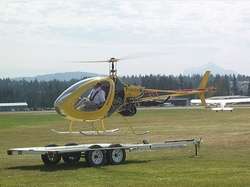 We'll be bringing you a photo or two of the first
customer-flight Helicycle, built by an extremely handy (he's a
designer and a machinist himself, for instance) Doug Schwochert, of
Burlington (WI) ASAP.
We'll be bringing you a photo or two of the first
customer-flight Helicycle, built by an extremely handy (he's a
designer and a machinist himself, for instance) Doug Schwochert, of
Burlington (WI) ASAP.
He flew the little single-place helicopter, after an extensive
checkout procedure by the machine's designer, BJ Schramm (seen
flying the prototype here), just a couple weeks ago. He hovered,
made quick stops, and eventually transitioned to horizontal flight,
as BJ showed the way. Doug himself is an R-22 pilot, and, according
to what we've heard, made the transition from that piston-powered,
two-place machine, to the turbine-powered single-seater that he
built himself, without any troubles, in the course of a very few
hours, spread over several days.
(Due to some publishers' agreements, the photos on the Helicycle
website aren't available for us to show you -- but you're free to
see for yourselves: www.helicycle.com/news/FHF.htm.)
Doug, wanting plenty of power, opted for a GPU-derived
single-spool turbine. This engine, although plenty powerful in its
own right, posed some interesting problems. For one, it's a GPU --
a ground power unit -- and as such, is carrying a lot of
unnecessary gearing, etc., around. That's just pure, unnecessary
weight -- weight which will soon be turned into useful load,
perhaps increased fuel, for the smooth, thirsty little powerplant.
For another, it's a single-spool design, which means its throttle
response is, um, slow. Fortunately, and against Schramm's original
intuition, the lag, in the small, lightweight design, was not a
show-stopper. One other thing: it turns the wrong way. That put a
lot of Doug's genius to the test; but he overcame it, and the rotor
blades now produce lift.
 As BJ explained, "Of course, as it is right now,
that machine is 'way too heavy. The engine's a GPU, with all kinds
of extra equipment on it, that doesn't need to be there, for
flying. The gearbox needs to be redesigned. Of course, it won't
carry a lot of fuel, until he gets the weight of the turbine down."
After that, Mr. Schramm thinks, "then, he could probably run it an
hour and twenty minutes, an hour and a half, with reserve." Power
most certainly isn't a problem. BJ figures, "Airspeed should
eventually be about 105mph -- in cruise." That way, "He should have
at least 100, maybe 120 miles' range, with reserve." Sounds good --
plenty good, for a decent-performing single-place chopper. "The
disadvantage is, you have to get jet fuel -- you can't just fill up
at a gas station. I suppose, if you're around home, you could fly
it on 60-cent kerosene, rather than jet fuel..."
As BJ explained, "Of course, as it is right now,
that machine is 'way too heavy. The engine's a GPU, with all kinds
of extra equipment on it, that doesn't need to be there, for
flying. The gearbox needs to be redesigned. Of course, it won't
carry a lot of fuel, until he gets the weight of the turbine down."
After that, Mr. Schramm thinks, "then, he could probably run it an
hour and twenty minutes, an hour and a half, with reserve." Power
most certainly isn't a problem. BJ figures, "Airspeed should
eventually be about 105mph -- in cruise." That way, "He should have
at least 100, maybe 120 miles' range, with reserve." Sounds good --
plenty good, for a decent-performing single-place chopper. "The
disadvantage is, you have to get jet fuel -- you can't just fill up
at a gas station. I suppose, if you're around home, you could fly
it on 60-cent kerosene, rather than jet fuel..."
That checkout:
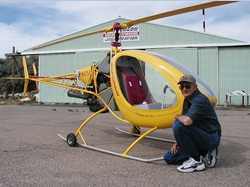 BJ Schramm, who saw what can go wrong in a
customer-built helicopter, through his RotorWay days decades ago,
doesn't want that to happen with the Helicycle. In fact, part of
the sales agreement requires the customer to have BJ check the
machine out before any flight. How can he enforce that? The factory
withholds a few critical parts, and brings them along, when the
checkout is scheduled. The checkout itself is rather comprehensive,
and covers both the machine and the pilot. Here's what Doug went
through, over the course of several days:
BJ Schramm, who saw what can go wrong in a
customer-built helicopter, through his RotorWay days decades ago,
doesn't want that to happen with the Helicycle. In fact, part of
the sales agreement requires the customer to have BJ check the
machine out before any flight. How can he enforce that? The factory
withholds a few critical parts, and brings them along, when the
checkout is scheduled. The checkout itself is rather comprehensive,
and covers both the machine and the pilot. Here's what Doug went
through, over the course of several days:
- A thorough mechanical conformity and construction checkout
using an itemized check list and special factory tooling.
- A rigging inspection of all controls & rotor system
components.
- A physical weight and balance hang test to insure that the c.g.
is absolutely correct for the very first liftoff.
- The main and tail rotor systems are final dynamically balanced
and readied for flight.
- Power plant break-in procedures are completed.
- The factory test pilot performs a comprehensive series of
flight tests including power off autorotations to insure correct
adjustment of all controls and flight surfaces prior to customer
operation.
- The customer is briefed on pre-flight checks and begins the
first tethered lift off's.
-
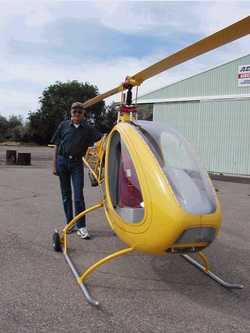 Following a brief period on the tether bar, the
customer lifts into his first free flight hover and continues to
gain confidence in his ability by performing in-ground effect
maneuvers under the test pilot's watchful supervision. Hovering the
HELICYCLE is quite easy for anyone with some training in the
R-22.
Following a brief period on the tether bar, the
customer lifts into his first free flight hover and continues to
gain confidence in his ability by performing in-ground effect
maneuvers under the test pilot's watchful supervision. Hovering the
HELICYCLE is quite easy for anyone with some training in the
R-22.
- Flight into and out of translational lift is practiced until
the customer has successfully completed accelerations and
decelerations (Low altitude, high angle quick stops) through
incrementally-increasing airspeeds up to 50 - 55 mph. Doug was able
to complete this phase in approximately and hour and a half. When a
helicopter pilot can capably perform a 55 mph high-angle quick
stop, he can also adequately perform the flare maneuver at the end
of an autorotation, so the factory check out is not completed
without the test pilot's confirmation that the customer understands
and is becoming proficient in this highly important maneuver.
- Climb out to altitude and, very soon thereafter, autrotative
entries may begin to be practiced by the customer during the
checkout. If not, he will continue with this practice on his own
and report his progress to the factory pilot who will consult with
him as he proceeds.
Although it sounds like a lot of additional hassle, Doug was
grateful for the opportunity. He didn't need too much help in the
mechanical/building department, given his considerable expertise,
and what he called the "great" construction instructions and
videos; but the flying -- that was a whole new thing.
As for the customers who are waiting for that checkout, BJ says
there are already "too many" waiting to see him show up, final
critical parts in hand, for that. Some already have the 90-hp T-62
APU, a much-easier, but more-expensive, option...
What Happened Recently, and What's Happening Next
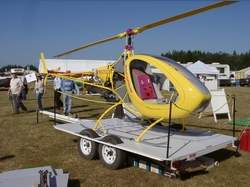 BJ, like just about everyone else who has to drive
from the northwest corner of the country to Florida in April, was a
tad rushed, as he set out for Sun 'n Fun. "I wasn't really ready to
hit the road for Sun 'n Fun. I forgot to drain the water -- I
didn't have any anti-freeze in it -- I was just test-flying." He
remembered to drain it, but then, in the haste of leaving, forgot.
"I forgot to drain the water," he told us. "I was in Rawlings (WY),
and the water jacket cracked in about five places," in the freezing
night. He made it to Sun 'n Fun for the opening, but he couldn't
fly until he had patched up the engine. "For 2 1/2 days, I'm at Sun
'n Fun, super-glueing the engine together," he said. "Carolyn, my
wife, was so upset, she said she didn't want me to fly over the
trees and the swamps."
BJ, like just about everyone else who has to drive
from the northwest corner of the country to Florida in April, was a
tad rushed, as he set out for Sun 'n Fun. "I wasn't really ready to
hit the road for Sun 'n Fun. I forgot to drain the water -- I
didn't have any anti-freeze in it -- I was just test-flying." He
remembered to drain it, but then, in the haste of leaving, forgot.
"I forgot to drain the water," he told us. "I was in Rawlings (WY),
and the water jacket cracked in about five places," in the freezing
night. He made it to Sun 'n Fun for the opening, but he couldn't
fly until he had patched up the engine. "For 2 1/2 days, I'm at Sun
'n Fun, super-glueing the engine together," he said. "Carolyn, my
wife, was so upset, she said she didn't want me to fly over the
trees and the swamps."
There's still plenty to do, though, if only an audience would
become available. BJ, quiet, but still a showman in the machine he
knows can do so much, wanted to show the meager crowds what his
creation could do: "I demonstrated throttle chops -- from about ten
feet. So, everybody thought I was having a lot of hard landings..."
That wasn't the worst of it, though. "Everybody comes on the first
day or two, or three," BJ noted. What happened was, it took him a
couple days to get the engine apart, glued-up, and back in the
Helicycle. "By the time I did get flying, 80% of the people had
already left the show. It's a poor show - poorly organized.
Everybody said it was the deadest show anyone had seen, ever."
High-altitude Testing
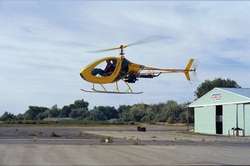 The country's tallest airport was almost in the
way, on the way home. BJ had to have a shot at it, glued-up engine
and all. "On the way back, we stopped in Leadville (CO); I got a
certificate of flying there." It was cold that day, so the density
altitude was "something just over 9000 feet," he said. "Actually, I
want to go back with the Hirth engine (90 hp), and do a complete
checkout. The rotor is lifitng close to 12 lbs per square foot. It
has tremendous inertia, for its diameter, because of its tip weight
and design. It flew well on the Rotax at Leadville -- I wasn't even
at full throttle," he told us.
The country's tallest airport was almost in the
way, on the way home. BJ had to have a shot at it, glued-up engine
and all. "On the way back, we stopped in Leadville (CO); I got a
certificate of flying there." It was cold that day, so the density
altitude was "something just over 9000 feet," he said. "Actually, I
want to go back with the Hirth engine (90 hp), and do a complete
checkout. The rotor is lifitng close to 12 lbs per square foot. It
has tremendous inertia, for its diameter, because of its tip weight
and design. It flew well on the Rotax at Leadville -- I wasn't even
at full throttle," he told us.
More Engine Options, Including an All-New, Fuel-Injected 90hp
Hirth
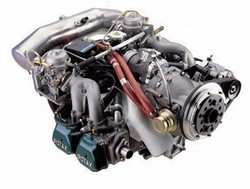 In
response to customer requests for a four-stroke powerplant, BJ has
worked out an arrangement with Rotax. It's just about finished, and
ready to fly. In fact, "We'll be flying the 912 (pictured)
at Arlington."
In
response to customer requests for a four-stroke powerplant, BJ has
worked out an arrangement with Rotax. It's just about finished, and
ready to fly. In fact, "We'll be flying the 912 (pictured)
at Arlington."
Now there's something for everybody. The original Helicycle has
a Rotax 582 in it, and there are more in the works. BJ said, "The
people that want 4-strokes, two-strokes, turbines -- we can satisfy
them all. Of course, a two-stroke is by far the easiest
installation."
There's a completely-new Hirth on the way. "At
first, it'll be generally-considered as the less-reliable engine;
but it's fully fuel injected; its's a pretty nice design -- time
will tell," BJ said. "It's a whole new thing for Hirth. They've
spent a lot of money -- some fabulous dyno rooms, some fantastic
development -- this engine is an outgrowth of that." It's a
three-cylinder, 90hp, water-cooled design, based on the model 3701.
BJ is enthusiastic: "They know what they're doing; and now that
they have the money, they're doing everything right. This newest
engine will be the basis for a whole new line of engines, I'm sure.
I think this may be the first [two-stroke] design to rival the
Rotax, for power density and reliability. It's really
advanced."
 Aero-News: Quote of the Day (08.28.25)
Aero-News: Quote of the Day (08.28.25) ANN's Daily Aero-Linx (08.28.25)
ANN's Daily Aero-Linx (08.28.25) Classic Klyde Morris (08.25.25)
Classic Klyde Morris (08.25.25) Airborne 08.25.25: Zenith Homecoming, VP Racing, Affordable Flying Expo 2025
Airborne 08.25.25: Zenith Homecoming, VP Racing, Affordable Flying Expo 2025 Airborne 08.22.25: ARC Spinoff, Nat'l Championship Air Races, Hawkins Accident
Airborne 08.22.25: ARC Spinoff, Nat'l Championship Air Races, Hawkins Accident









